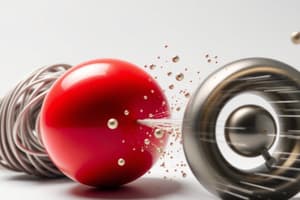Podcast
Questions and Answers
What factors can contribute to an object having a large momentum?
What factors can contribute to an object having a large momentum?
- Large velocity only
- Large mass only
- Small mass and small velocity
- Both large mass and large velocity (correct)
Why can a huge ship moving at a small velocity have a large momentum?
Why can a huge ship moving at a small velocity have a large momentum?
- Due to its large mass (correct)
- Due to its small size
- Due to the force acting on it
- Due to its small mass
What happens to an object's momentum when its mass remains unchanged but its velocity changes?
What happens to an object's momentum when its mass remains unchanged but its velocity changes?
- The momentum decreases
- The momentum fluctuates randomly
- The momentum increases (correct)
- The momentum remains constant
Why does applying a force briefly to a stalled automobile result in a small change in momentum?
Why does applying a force briefly to a stalled automobile result in a small change in momentum?
What is essential in changing momentum besides force?
What is essential in changing momentum besides force?
What is the relationship between impulse and change of momentum?
What is the relationship between impulse and change of momentum?
How is impulse related to changing momentum over a long time?
How is impulse related to changing momentum over a long time?
In the equation Ft = change in(mv), what does 'Ft' represent?
In the equation Ft = change in(mv), what does 'Ft' represent?
When considering the impulse-momentum relationship, what is sometimes considered to be the cause of an impulse?
When considering the impulse-momentum relationship, what is sometimes considered to be the cause of an impulse?
How does the relationship between impulse and change of momentum relate to forces and motion?
How does the relationship between impulse and change of momentum relate to forces and motion?
Which term is introduced to represent 'change in' or 'difference in' when expressing all terms in shorthand notation?
Which term is introduced to represent 'change in' or 'difference in' when expressing all terms in shorthand notation?
What does the rearrangement of Newton's second law, F = ma, give when expressed equivalently?
What does the rearrangement of Newton's second law, F = ma, give when expressed equivalently?
What relationship does the text highlight between force acting over a time interval and the resulting effect on momentum?
What relationship does the text highlight between force acting over a time interval and the resulting effect on momentum?
Flashcards are hidden until you start studying




